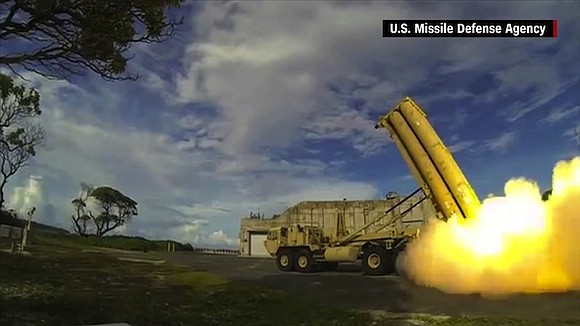US Says Missile Defense System Successfully Intercepts Projectile During Test
CNN/Stylemagazine.com Newswire | 7/11/2017, 9:09 a.m.
By Joshua Berlinger and Michael Callahan
CNN
(CNN) -- A United States-built missile defense system on Tuesday successfully intercepted its target during a test run, the US Missile Defense Agency said.
The Terminal High Altitude Area Defense (THAAD) missile defense system successfully shot down a target over Alaska, according to a news release.
"I couldn't be more proud of the government and contractor team who executed this flight test today," said MDA Director Lt. Gen. Sam Greaves in the statement. "This test further demonstrates the capabilities of the THAAD weapon system and its ability to intercept and destroy ballistic missile threats."
An official with the US Department of Defense told CNN the test is not related to North Korea's recent intercontinental ballistic missile (ICBM) launch.
Each THAAD system is comprised of five major components: interceptors, launchers, a radar, a fire control unit and support equipment, according to Lockheed Martin, the security and aerospace company that serves as the prime contractor.
It's is designed to shoot down short, medium and intermediate ballistic missiles with shorter ranges than the ICBM that North Korea launched July 4.
The radar first detects an incoming missile. Those manning the system identify the threat, then a launcher mounted to a truck fires a projectile, which Lockheed Martin calls an "interceptor," at the ballistic missile in the hopes of destroying it using kinetic energy -- basically just its sheer speed.
Some analysts liken it to shooting down a bullet with another bullet.
Tensions on the peninsula
In the wake of the ICBM test, the US military and intelligence communities began to take a second look at the latest intelligence about North Korea's nuclear warhead program, according to two US defense officials.
North Korea has previously claimed it has successfully miniaturized a nuclear warhead that could go on the front end of an intercontinental ballistic missile.
Though analysts say it's quite difficult to verify that claim, US commanders have decided, for the purposes of planning military options, they have to assume Pyongyang has that capability.
"I know there's some debate about the miniaturization advancements made by Pyongyang," Adm. Harry Harris, head of US Pacific Command, said in a speech last month. "I take him at his word. I must assume his claims are true -- I know his aspirations certainly are."
The escalation of Pyongyang's nuclear program also has prompted a closer look at the effectiveness of missile defense systems maintained by the United States and its allies.
The US military had already begun deploying the THAAD system in South Korea earlier this year, much to the chagrin of some of Seoul's neighbors.
Its presence is vociferously opposed by China, Russia and North Korea, which all say THAAD is fueling an arms race. Analysts note that Beijing's biggest concern is likely that THAAD's powerful radar could be used to snoop inside China and negate its own deterrent capabilities.
But the system has detractors in South Korea, as well. THAAD's deployment was approved by disgraced ex-President Park Geun-hye, who is currently on trial in a corruption scandal. Her more dovish successor, Moon Jae-in, campaigned on a promise to put the issue to the country's Parliament.
Moon has suspended the THAAD deployment, pending an environmental impact assessment.
Earlier tests
Last month, a US and Japanese missile test conducted in Hawaii missed its target, but both stopped short of calling it a failure.
In May, the Pentagon successfully shot down an intercontinental ballistic missile using its own upgraded long-range interceptor missile.
That test involved firing a new version of the military's single long-range, ground-based interceptor missile, which is currently based in Alaska and California. That program has been in existence for more than a decade, but only about half of the tests have been successful, according to the Defense Department.
While the Pentagon called the test a success, some experts cautioned that the $40 billion missile defense system still has a long way to go before it can be considered fully developed.
CNN's Barbara Starr and Zachary Cohen contributed to this report









